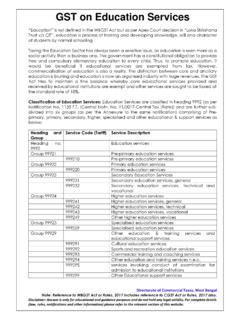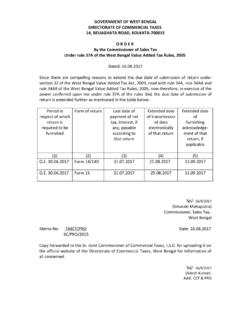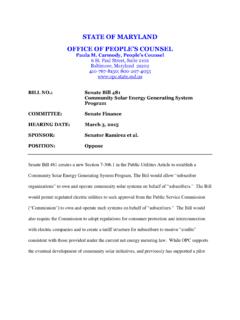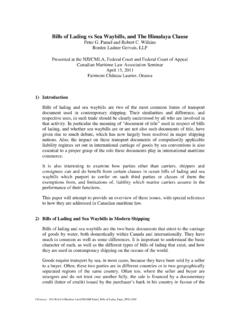Transcription of Electronic Way Bill in GST - wbcomtax.gov.in
1 Electronic Way bill in GST Directorate of Commercial Taxes, West Bengal Note: Reference to WBGST Act or Rules, 2017 includes reference to CGST Act or Rules, 2017 also. Disclaimer: Answer is only for educational and guidance purposes and do not hold any legal validity. For complete details (law, rules, notifications and other information) please refer to the relevant section of this website. Introduction A waybill is a receipt or a document issued by a carrier giving details and instructions relating to the shipment of a consignment of goods and the details include name of consignor, consignee, the point of origin of the consignment, its destination, and route.
2 Electronic Way bill (E-Way bill ) is basically a compliance mechanism wherein by way of a digital interface the person causing the movement of goods uploads the relevant information prior to the commencement of movement of goods and generates e-way bill on the GST portal. Rule 138 of the WBGST Rules, 2017 provides for the e-way bill mechanism and in this context it is important to note that information is to be furnished prior to the commencement of movement of goods and is to be issued whether the movement is in relation to a supply or for reasons other than supply.
3 E-Way bill under GST E-way bill is an Electronic document generated on the GST portal evidencing movement of goods. It has two Components-Part A comprising of details of GSTIN of recipient, place of delivery (PIN Code), invoice or challan number and date, value of goods, HSN code, transport document number (Goods Receipt Number or Railway Receipt Number or Airway bill Number or bill of Lading Number) and reasons for transportation; and Part B comprising of transporter details (Vehicle number). As per Rule 138 of the WBGST Rules, 2017, every registered person who causes movement of goods (which may not necessarily be on account of supply) of consignment value more than Rs.
4 50000/- is required to furnish above mentioned information in part A of e-way bill . The part B containing transport details helps in generation of e-way bill . Who should generate the e-way bill and why? E-way bill is to be generated by the consignor or consignee himself if the transportation is being done in own/hired conveyance or by railways by air or by Vessel. If the goods are handed over to a transporter for transportation by road, E-way bill is to be generated by the Transporter. Where neither the consignor nor consignee generates the e-way bill and the value of goods is more than ,000/- it shall be the responsibility of the transporter to generate it.
5 Further, it has been provided that where goods are sent by a principal located in one State to a job worker located in any other State, the e-way bill shall be generated by the principal irrespective of the value of the consignment. Also, where handicraft goods are transported from one State to another by a person who has been exempted from the requirement of obtaining registration, the e-way bill shall be generated by the said person irrespective of the value of the consignment. Electronic Way bill in GST Directorate of Commercial Taxes, West Bengal Note: Reference to WBGST Act or Rules, 2017 includes reference to CGST Act or Rules, 2017 also.
6 Disclaimer: Answer is only for educational and guidance purposes and do not hold any legal validity. For complete details (law, rules, notifications and other information) please refer to the relevant section of this website. How is it generated? An e-way bill contains two parts- Part A to be furnished by the person who is causing movement of goods of consignment value exceeding ,000/- and part B (transport details) to be furnished by the person who is transporting the goods. Where the goods are transported by a registered person whether as consignor or recipient, the said person shall have to generate the e-way bill by furnishing information in part B on the GST common portal.
7 Where the e-way bill is not generated by registered person and the goods are handed over to the transporter for transportation by road, the registered person shall furnish the information relating to the transporter in Part B of FORM GST EWB-01 on the common portal and the e-way bill shall be generated by the transporter on the said portal on the basis of the information furnished by the registered person in Part A of FORM GST EWB-01. A registered person may obtain an Invoice Reference Number from the common portal by uploading, on the said portal, a tax invoice issued by him in FORM GST INV-1 and produce the same for verification by the proper officer in lieu of the tax invoice and such number shall be valid for a period of thirty days from the date of uploading.
8 In the above case, the registered person will not have to upload the information in Part A of FORM GST EWB-01 for generation of e-way bill and the same shall be auto-populated by the common portal on the basis of the information furnished in FORM GST INV-1. Upon generation of the e-way bill on the common portal, a unique e-way bill number (EBN) generated by the common portal, shall be made available to the supplier, the recipient and the transporter on the common portal. The details of e-way bill generated shall be made available to the recipient, if registered, on the common portal, who shall communicate his acceptance or rejection of the consignment covered by the e-way bill .
9 In case, the recipient does not communicate his acceptance or rejection within seventy-two hours of the details being made available to him on the common portal, it shall be deemed that he has accepted the said details. Purpose of E-Way bill E-way bill is a mechanism to ensure that goods being transported comply with the GST Law and is an effective tool to track movement of goods and check tax evasion. Validity of E-Way bill The validity of e-way bill depends on the distance to be travelled by the goods. For a distance of less than 100 Km the e-way bill will be valid for a day from the relevant date.
10 For every 100 Km thereafter, the validity will be additional one day from the relevant date. The relevant date shall mean the date on which the e-way bill has been generated and the period of validity shall be counted from the time at which the e-way bill has been generated and each day shall be counted as twenty-four hours. In general, the validity of the e-way bill cannot be extended. However, Electronic Way bill in GST Directorate of Commercial Taxes, West Bengal Note: Reference to WBGST Act or Rules, 2017 includes reference to CGST Act or Rules, 2017 also.














